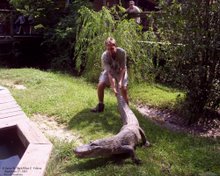It's been a while since we've had a post on this blog. To tell the truth, I forgot my username and/or password. You know how that goes, you try a thousand different combinations, and nothing works. Then finally, you find where you put it so that you could "find it" if you were ever to forget it. Right....
Anyway, enough about that. This past summer I did a lot of field work up in the Tensas River Basin as well as the White and Cache River Basins of Arkansas. The work was centered around the amphibian research we had been working on, but also now there was a new phase: plants. I got to work with Dr. Bobby Keeland and John McCoy in the field on the plant project. I'll get to that in a minute. First thing's first. While working out in the Buckhorn WMA in Tensas Parish, Susan Walls and I finally stumbled upon what we were really hoping to find while working up there....the mighty CANEBRAKE RATTLESNAKE.

It's pretty funny how we came across the first one, actually. I was leading the way via GPS to one of our frogloggers, deep in the thick, palmetto-covered undergrowth of the forest. I happened to trip over some exposed roots, and landed palms-first on a spread of blackberry (
Rubus sp.). Now, previous to this, Susan had been stung four times already by yellowjackets (
Vespula sp.)! So, candidly, I told her that I had thorns in my fingertips to make up for not being stung. Just then, I caught a glimpse of something moving on the forest floor right next to where I stood. When my eyes adjusted to the low light, there was a very large canebrake rattlesnake (
Crotalus horridus)! The snake was at least 5' in length, and had an impressive girth. The pictures do the snake NO justice. The conditions were such that a "perfect" picture was not attainable without further agitating the snake. As it was, the snake showed no signs of aggression...no rattling. But, we didn't want to take any uneccessary chances way out here. Plus...one of us (hint, NOT Susan) has been bit by this species before, and not looking for a rematch. The snake we found is illustrated below.

Unbelievably, about 20 minutes after finding this first rattler, I found another one! Susan didn't believe me at first. Only after seeing me taking a picture of something did she come over for a look. This individual was smaller, and thinner than the first, but the picture came out better of this one....figures.
It's been a long time now since I've been up in Tensas. I look to be back up there again the last week of February. It might be too cold for most snakes then, but I'll be constantly be looking...for the rattlers of the canebrake.






















